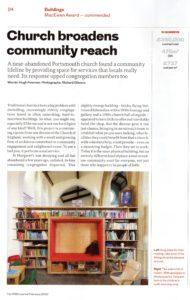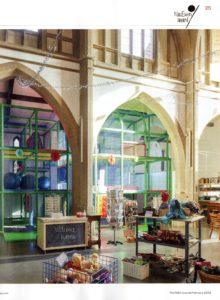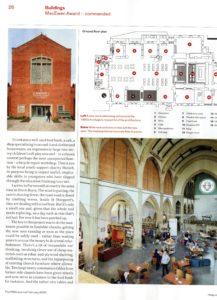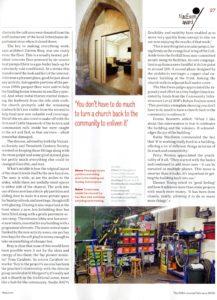Homebuilding & Renovating Magazine
Holly Cottage was featured as a full, in-depth case study feature in Homebuilding & Renovating Magazine. The monthly magazine offers design ideas, inspiration and clever design solutions to inspire the self builders.
The Institute of Structural Engineers
We were thrilled to have our Cedarwood project feature on the front of the latest Institute of Structural Engineers magazine, the flagship journal is globally recognised for showing the best of best and most interesting structural engineering projects.
We worked with the very talented team at Agnos Studio to convert the dated 1950’s colt, timber framed house into a contemporary family home.
Architects Journal
The Architects Journal published news of our Girl Guides Hut being submitted for planning. The sustainably designed building will have low running costs, to make it an economical building for the charity to run. Due to the conditions of the site the building has been carefully crafted to maximise the space available, whilst fitting within the mature trees onsite and touching the ground lightly on screw piles.
You can read full article here.
Inclusion Emergency, Diversity in Architecture
Darren was invited to offer his insights on the Architectural profession for the new ‘Inclusion Emergency, Diversity in Architecture’ by Hannah Durham and Grace Choi produced by RIBA Publishing.
Within the book are insights from many leading voices, including Amy Francis-Smith, Clare Nash, Mary Holmes, Nick Walker and Sumita Singha to name a few. Each individual highlights a different topic and expresses their experiences to provide a rich foundation for a future of architecture, representing the diverse population the RIBA serve.
The book is now available from RIBA Books online
Homebuilding & Renovating Magazine
I was asked to predict the a key trend for 2023, by Homebuilding & Renovating Magazine, the key trend I can see is deep retrofit of existing buildings. We are already seeing this in the self-build industry, where homeowners and those investing in new properties and projects are looking to invest in the fabric of their buildings so that they can save energy in the long term. This is in response to the challenging times we face, with energy costs, rising inflation and how this impacts on construction costs.
So this may include new triple glazed windows, insulating the fabric of a building first, existing walls, roof and floor. It makes sense to put investment into the existing envelope of the building first, before investing in the interiors such as kitchens, bathrooms, lighting and decoration. There is a move to upgrade building fabric now, so that money can be saved and put aside for further improvements on buildings.
RIBA Journal
I was honoured to be interviewed by Helen Castle for the RIBA Journal, for a recent article looking at dyslexia within the architectural industry. It was a refreshing take on how this difference to learning can be a huge positive, especially a creative industry like architecture, rather than the hinderance it was historically perceived.
Having lived with dyslexia myself I found the traditional school system particularly difficult, which I believe was partly due to having it undiagnosed for so long. I was fortunate that I was able to find my passion for architecture (through a Youth Training Scheme & a very inspiring teacher in Roger Tyrell) and found that my dyslexia is not an obstacle, but in many ways it feels like a ‘superpower’.
The full article can be found here
AJ Building Library
The St Margaret’s Church project has been included in the Architects Journal online ‘Building Library’. The online resource showcases thousands of buildings mainly from the last 20 years, these can be cleverly searched by categories such as cost, size, location or project type.
It is wonderful to have the church project included in this illustrious list of buildings.
RIBA Journal
St Margaret’s Church was commended in the RIBA MacEwean Awards, the awards set up to celebrate architecture for common good. The article takes a detailed look into the project, how Studio BAD took the nearly-abandoned church and have created a new hub for the community, by providing space for services that locals really need.
Article written by Hugh Pearman
RIBA Journal
RIBA MacEwean Award shortlist article showcases St Margaret’s Church. Studio BAD worked on the near-abandoned church, in the Portsea area of Portsmouth, transforming the building and delivering a new focal point for the community which offers multiple functions, such as a food bank, cafe, soft-play area and bicycle repair workshop alongside the traditional church offerings.
Article written by Hugh Pearman
Architects Journal
The latest in a series of practice profiles looking at those who have recently decided to go it alone. Today former PAD Studio associate Darren Bray on his new studio..
E architect
October books was formed in 1977 in Southampton in Portswood High street. It is a non for profit co-operative radical neighborhood independent book shop. The shop itself is independent from any political organization, and looks to promote a fair and equal society.
The Guardian
About 250 people formed a human chain to help a community bookshop in Southampton move to a new store after a rent increase left them unable to afford their old premises.
BBC News
About 250 people formed a human chain along a street and lent a hand to help a bookshop move to new premises.
RIBA Role model project
Darren started his architectural career as a technician on a youth training scheme before going on to train as an architect at Portsmouth University School of Architecture. He now teaches part-time at Portsmouth School of Architecture, and is a visiting critic at Brighton University. Darren founded Studio B.a.d. Architects in 2018.
RIBA Guerrilla Tactics lecture
RIBA Guerrilla Tactics 2017 – The Power of Small. Our Approach to Change – Darren Bray, Pad Studio. Held at the Royal Institute of British Architects on 14 November 2017
The Place of Glorious Failure Documentary
RIBA Journal
Undiagnosed dyslexia meant Darren Bray left school with one GCSE above D. Meeting the right mentors, and his own determination, led him to become an RIBA Role Model
RIBA Conversation
Darren And Tayseer Talk About Confidence, Philosophy And Practical Benefits Of Mentoring
Homebuilding & Renovating Magazine
Darren is and has been a regular contributor to Home Building & Renovating over the past 10 years, submitting projects, expert pieces on architecture and the built environment, as well as judging the Daily Telegraph HBR awards. Here is a small section of some recent articles.
Read the article here
Read the article here
Read the article here
Three Paradigms of Architecture
Darren was invited by leading academic and writer Roger Tyrrell to contribute to his latest book
Three Paradigms of Phenomenological Architecture
This book examines the work of three seminal Nordic architects – Alvar Aalto, Jørn Utzon and Sverre Fehn – from a phenomenological perspective, utilising the methodology of ‘paradigm’ (or ‘in the manner of”). Roger Tyrrell explains how the approach of each architect is defined by the three sub-frames of the paradigm: that of the ‘origin’ (arche), that of ‘revealing’ (techne), and that of ‘the poetic conjunction’, in order to gain a holistic understanding of the experiential or phenomenological predisposition of the three architects. Using this method the author describes the commonalities and distinctive qualities of the architecture and design methods of Aalto, Utzon and Fehn. The final chapter projects the intellectual heritage of the three protagonists into the contemporary world, examining the work of practices from the UK, Norway and the USA that each extend this particular way of making place.



